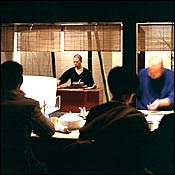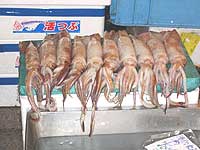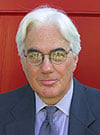|
From New York: The Masa ExperienceThe Best Counter Dining in the U.S.?by John Mariani
What's the price of glory? In the case of Masa, start with $300 per person, plus beverages, an automatic 18% service charge and NYC sales tax. So figure about $400 or more. If you have a problem spending that much money on a meal, I feel your pain. It is a helluva lot of dough to spend in an evening for the delectation of one's palate. Yes, I know that courtside Knicks tix can cost $1,000 a seat (if you find a charitable scalper), and there are people who giddily spend $600 for a pair of shoes they may wear once in a season. So, if money's no object in such matters, I absolutely, positively urge you to enjoy yourself at Masa, which is quite possibly the best Japanese restaurant in America. If, however, you are offended by such extravagance, Masa is testament to just how profligate dining out has become in some quarters, in this case the new Time Warner Center at Columbus Circle. Its fourth floor is home to Thomas Keller's Per Se, where you can easily spend $300 per person for dinner, and V Steakhouse, where a porterhouse goes for $62. Having therefore given you fair warning, let me proceed to tell you about the Masa experience. Since a mighty reputation precedes Masayoshi Takayama as the former sushi master at Beverly Hills' Ginza Sushi-Ko (where meal tickets were only slightly less expensive than in NYC), everyone expected that obtaining one of the ten seats at the counter here would be tantamount to getting a front row seat for a new Broadway hit the night after the rave reviews came in. Yet when I visited mid-week, I found Masa nearly empty at 7:30 p.m. There were only four people at the sushi counter (one was Rocky H. Aoki, founder the Benihana restaurant chain), and by 9 p.m. there were just my wife and I and one other couple, eating in near silence. (There are two small, dull rooms also available for private dining; one was taken that evening.) A lone straggler—who happens to be one of Miami's finest chefs—wandered in and was immediately seated without a reservation. Later, upon presentation of the bill, she went into serious sticker shock. The nicely lighted counter space is very simple and quite refined, though not much different looking than many other sushi counters around town. The smooth, beautiful counter is made from Masa's favorite wood, hinoki, and all wood, stone and bamboo design elements, selected by architect Richard Bloch, have been specially brought in from Japan—as is most of the seafood at Masa.
This importation, in fact, is what Masa contends sets his food apart from the rest: The ingredients are exceedingly expensive. (Thank the gods for FedEx and DHL, but at these prices I trust the fish flew first class.) A smiling, congenial Masa stands before you, and he has sworn he will always be there—unlike his globetrotting colleague Nobu Matsuhisa, who flits among his dozen or so namesake restaurants while also doing celebrity cooking stints. "It is the respect I owe my customers," he told me. Indeed, this makes Masa even more special: The man is all yours for the evening and you are all his. His English is halting but earnest (other staff members, who barely earn that 18% service charge by doing little more than bringing and removing your plates, help with the translation of fish species). You are poured a little sake from a green bottle into a cypress cup, at which point I began to feel a bit like Alice in Wonderland, for, as a Japanese magazine explains, "The cup, which holds only 60 milliliters, is so tiny that it will spill its contents unless extreme care is used when filling it. The bottle has been meticulously designed and crafted so the precise contour of the neck controls the amount that can be poured, and the cup will not overflow. The sake cup itself was carved to less than 1 millimeter in thickness with the craftsman's most delicate touch. When lips meet the edge of the cup, the subtle aroma of cypress drifts into the nostrils, enthralling the sipper with simultaneous pleasures of touch, taste, and scent." Right! Over the course of the next two or more hours, Masa and his assistants prepared an array of sushi and other dishes of sheer delight. Of more than 20 items, not one was less than stellar, beginning with a little dish of shredded, pickled seafood. Next came toro (tuna belly) tartare with a touch of caviar and toast; the fish's pristine quality and high fat content drove me to crave another bite. But Masa had other ideas: Sea bass with sprouts and aromatic leaves, vinegar and salt (which sushi chefs call namino hana ("flower of the waves"), a dish that left a bitter-salty tingling sensation on the tongue, which lingered for minutes before the next course: a very meaty greenling cod, called ainame in Japanese, with shishito pepper. A little bowl of foie gras and a sharp-toothed eel called hamo came in a delicate soy broth, a signature Masa shabu-shabu-style dish that deserves its fame—the velvety foie gras barely melting in the broth, the fish adding briny nuance to the fatted morsel. To clear the palate another broth was presented, this one made with dry seaweed. Then an array of fabulous sushi of a quality I have rarely tasted in this country. There was pale pink, fatty toro, shimaji (striped jack), tai (sea bream), aoyagi (clam), ebi (shrimp), red clam, hotategai (scallops), and kohada (the herring-like gizzard shad), all of which change on the menu by season. As Masa explains, "I want to know what the food is eating," meaning that whatever the fish consume will affect their flavor when served raw. We were far from finished: Grilled shiitakes came next, followed by a sweet shrimp just barely cooked and still translucent, then grilled saba (mackerel), and shako (crayfish), Santa Barbara sea urchin, cooked tuna, and, a little surprisingly, some make sushi rolls. One would think by then we would be either bloated or growing gills, but in fact, we felt completely satisfied, sated but not uncomfortable, which is a great credit to Masa's sense of balance. By the same token, I don't think I would have wanted a single morsel more, so I left Masa believing I'd had a perfect meal. If perfection
comes at so high a price (with wine, our bill came to
$900), it is an experience I will treasure. I just
don't have the treasure to enjoy a meal at Masa very
often. Masa, 10
Columbus Circle, 4th Floor, 212-823-9800
(Updated:
09/15/10 NW) |
Try these whiskey cocktails inspired by Beyoncé's Cowboy Carter album.
Check the recipes.
This cashew aioli recipe gets a kick with bourbon.
Get the recipe.
 Over the years, we have been electing restaurants to be on GAYOT's Yearly Restaurant Awards.
Over the years, we have been electing restaurants to be on GAYOT's Yearly Restaurant Awards.Check the list.














 John
Mariani is well known for his
frank and poignant writing in
Esquire, Wine
Spectator, Diversion and
the Harper Collection. He is
author of The Encyclopedia of
American Food & Drink, The
Dictionary of Italian Food and
Drink and co-author, with his
wife, of the Italian-American
Cookbook.
John
Mariani is well known for his
frank and poignant writing in
Esquire, Wine
Spectator, Diversion and
the Harper Collection. He is
author of The Encyclopedia of
American Food & Drink, The
Dictionary of Italian Food and
Drink and co-author, with his
wife, of the Italian-American
Cookbook.

